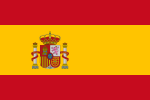Royal Spanish Navy
| Spanish Navy Armada Española |
|
|---|---|

Emblem of the Spanish Navy
|
|
| Active | 13th century — present |
| Country |
|
| Branch | Spanish Armed Forces |
| Type | Navy |
| Size | 20,838 personnel (2012) 131 ships 59 aircraft |
| Part of | Ministry of Defence |
| Garrison/HQ |
|
| Patron | Virgen del Carmen |
| March | Himno de la Escuela Naval (José María Pemán) |
| Anniversaries | 16 July |
| Website | www |
| Commanders | |
| Commander in Chief | King Felipe VI |
| Subcommander in Chief | Mariano Rajoy Brey (Prime Minister) |
| Subcommander in Chief | María Dolores de Cospedal García (Minister of Defence) |
| Chief of the Naval Staff (Jefe de Estado Mayor de la Armada) | Admiral Teodoro E. López Calderón |
| Chief during operational deployments | Chief of the Armed Forces (Jefe de Estado Mayor de la Defensa) |
| Chief during non-operational periods | Chief of Naval Operations |
| Insignia | |
| Naval jack |  |
| National Ensign |  |
| Aircraft flown | |
| Attack | Harrier AV8+ |
| Helicopter | Sikorsky SH60 SeaHawk |
| Cargo helicopter | Sikorsky SeaKing |
| Multirole helicopter | Augusta Bell 212 |
| Patrol | P-3 Orion |
| Trainer | Hughes 500 |
| Transport | Cessna Citation |
The Spanish Navy (Spanish: Armada Española), is the maritime branch of the Spanish Armed Forces and one of the oldest active naval forces in the world. The Spanish navy was responsible for a number of major historic achievements in navigation, the most famous being the discovery of America and the first global circumnavigation by Magellan and Elcano. For several centuries, it played a crucial logistical role in the Spanish Empire and defended a vast trade network across the Atlantic Ocean between the Americas and Europe and across the Pacific Ocean between Asia and the Americas.
The Spanish Navy was one of the most powerful maritime forces in the world in the 16th and 17th centuries and possibly the world`s largest navy at the end of the 16th century and in the early 17th century. Reform under the Bourbon dynasty improved its logistical and military capacity in the 18th century, for most of which Spain possessed the world's third largest navy. In the 19th century, the Spanish Navy built and operated the first military submarine, made important contributions in the development of destroyer warships, and achieved the first global circumnavigation by an ironclad vessel.
Currently, the Spanish 'Armada' is the third largest navy in Europe, after the British Royal Navy and the French Navy, and the sixth in the world ranking.
The main bases of the Spanish Navy are located in Rota, Ferrol, San Fernando and Cartagena.
...
Wikipedia
